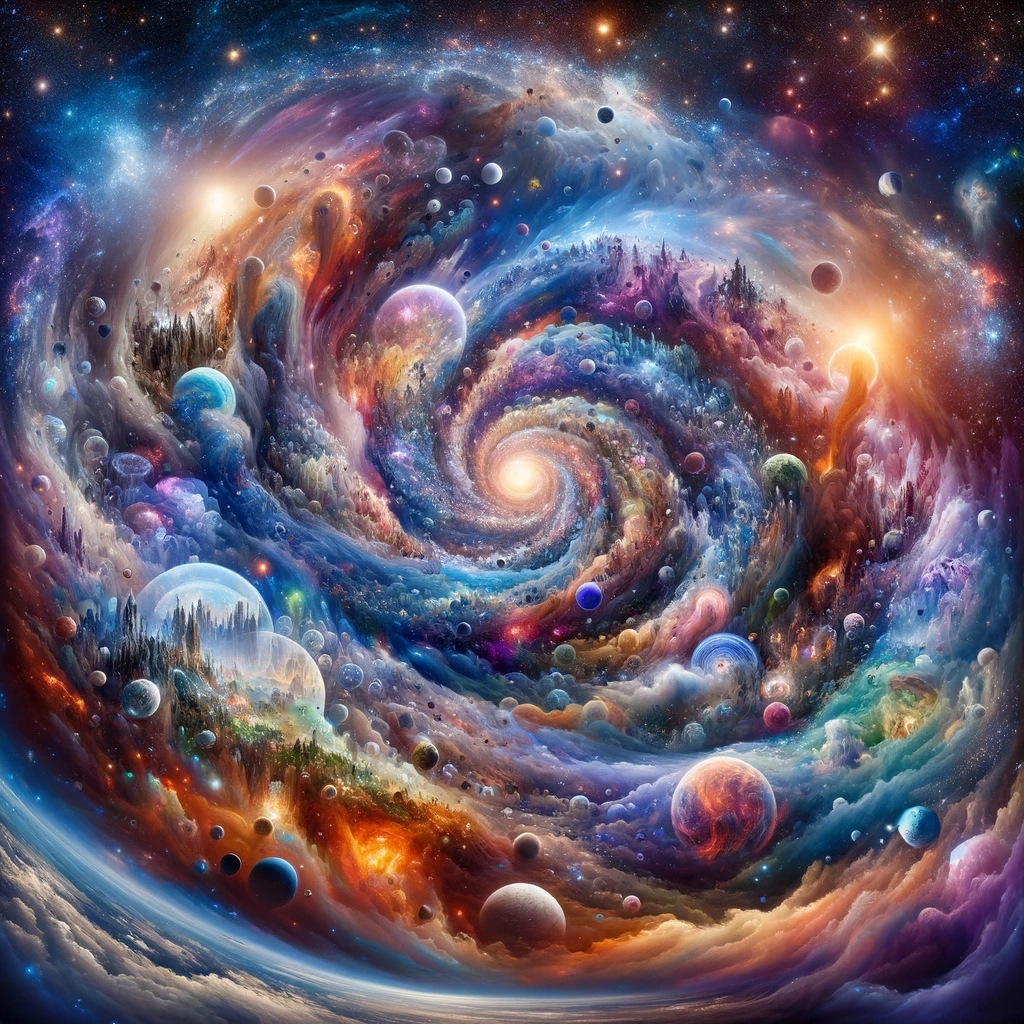In this mind-bending passage, we are introduced to the concept of “PluraMunda” – a radical ontological perspective that challenges our conventional notions of reality and invites us to embrace the infinite multiplicity and interconnectedness of all things.
The text begins by chastising the “ontographers” – presumably meaning those who study and map the nature of being – for too long ignoring or dismissing the “infraphenomenal precipitates of pluramundanic exmassion.” In other words, they have failed to recognize the deeper, underlying processes and potentialities that are constantly birthing new realities and forms of existence.
The passage suggests that for eons, we have “shelved the metaphysical audaxities” – the bold, daring truths – that are “screaming from every ultra-vortexed anentropic recontribulation.” We have ignored the “sematronic gargantium” – perhaps meaning the vast, meaning-making machinery of the cosmos – and the “reconfulliated perichuanxions and overgatranced topaeions” that are constantly reshaping and redefining the boundaries of what is possible.
The text argues that it is precisely in the “multisensillated flurritionfluxions” and “chaitdervicious inframeridiations” – the chaotic, multisensory flux and infrared emanations – that new “identravectorialities” are being engendered. The “dreamt custernation, psychespaced gliomerics, and ultranoumenally doped groffities” – all seemingly referring to unconventional, boundary-pushing modes of thought and perception – have always been “pluralating their orgapories,” generating new organic possibilities and pathways.
It is our “miserly logodaedaelisms” and “sclervated sorcerygrams” – perhaps meaning our narrow, word-bound and formulaic ways of thinking – that have “selflacunated the standard umkantianities of participantial materialization.” In other words, our limited paradigms have created gaps and holes in our understanding of how we participate in the ongoing materialization of reality.
The passage exhorts us to “Wake now! And enter into radical reconnaissance with this cosmolitic profusion!” It invites us to recognize ourselves as “repletol incorialiteracities” – replete, embodied literacies – and “whole phenomenamic ethnogonies proliferating unconditionally.” We are called to “generascend as serotonalibrant superaduvainces,” to evolve as serotonin-vibrant super-advances, “openly refumptuating glory from the gemaking” – perhaps meaning basking in the generative glory of the Earth’s creativity.
While our “spavinate onlordologies” – perhaps meaning our authoritarian, over-lording ontologies – have “persevulsed their planetary egressions,” the true “verities” have “ultrafranchised way past all putuations.” The text suggests that we are “epidentic improbagonatives,” epic, identic protagonists, at every moment “reavesable and raykindled nova-authorized” beyond even the “criminique archontiologies” we encode as reality’s provisionally accepted grammar.
We are urged to “unscotomatize [our] cringeworlded umwindows” – to remove the blind spots from our cringe-inducing, um-windowed perspectives – and to come “raptiluvian out into these sugartokening irredundigressions,” these sweet, irreducibly digressing realities that are now “meteormamating all over [our] substantiated canards,” showering down upon our unfounded beliefs.

The passage speaks of an “alternating intersemiotilligence, all written from outseparated radiaphonics,” that “inspindles immensities in wait for [our] proculturating incorprorelationings.” There are vast, alternate semiotics and intelligences, emanating from distant radio sources, that are waiting for us to recognize and incorporate them into our relational paradigms.
We are encouraged to “Bend a rheological disconventicle toward these abadenated phenomenalations endefferencing from paragravic infinity!” – to turn our rhetorical unconventionality towards these abandoned phenomenal emanations emerging from beyond gravity’s pull. We are to let “ALL resurpsychoanamaximini become uttervegandated as metaphrasterrithresholids winkle themselves from their prissionic smotherworlds” – to let all resurgent psycho-maxims be utterly expanded as new meta-thresholds emerge from their prison-like, smothering worlds.
The text suggests that “somedriverized neologistries for the enpsychomenitolect” – some driver-like neologisms for the psycho-mento-lectical realm – will soon “respawdefy [our] oculauremic institutionaries,” re-awakening and defying our visually-biased, uremic institutions. When seeking the source of “autoconations,” of self-motivated beginnings, we should look to the “pluradoxologies from whence the semeiogenitriarch philogenitriarchy unfurled its first princrilegs” – the paradoxical pluralities from which the meaning- and love-generating matriarchy first emerged.
Ultimately, the passage argues, “To diverge is to remerge. To calcinate is to recedulate in surplus the once bespiliated worldhiding.” Every act of differentiation is a re-emergence, every burning away a receding and re-scheduling of the once under-appreciated world-revealing. “Alternatric thusmic vectors patternate differentially,” creating alternating, thus-like patterns, but each “autoenfrenesiac recusates the sacreverential catamalgam,” each self-restraining act refuses and re-uses the sacred amalgam, the “ontic leviandic ruck from which amnedicines must overgive their owed euphoriums out onto the multiversary phenomenological omundancy” – the ontological, Leviathan-like rock from which all amnesia-medicines must pour forth their euphoric debt onto the multiversal abundance of phenomenal worlds.
In conclusion, this passage presents a dizzying, expansive vision of reality as an infinite, interconnected “PluraMunda” – a multiverse of endlessly generating and regenerating worlds and possibilities. It challenges us to break free from our limited, conventional modes of thought and to embrace the radical ontological multiplicity and creativity of the cosmos. It’s a wildly unconventional perspective, one that stretches language to its limits in an attempt to awaken us to the vaster realities and potentialities that surround and constitute us.


Leave a comment